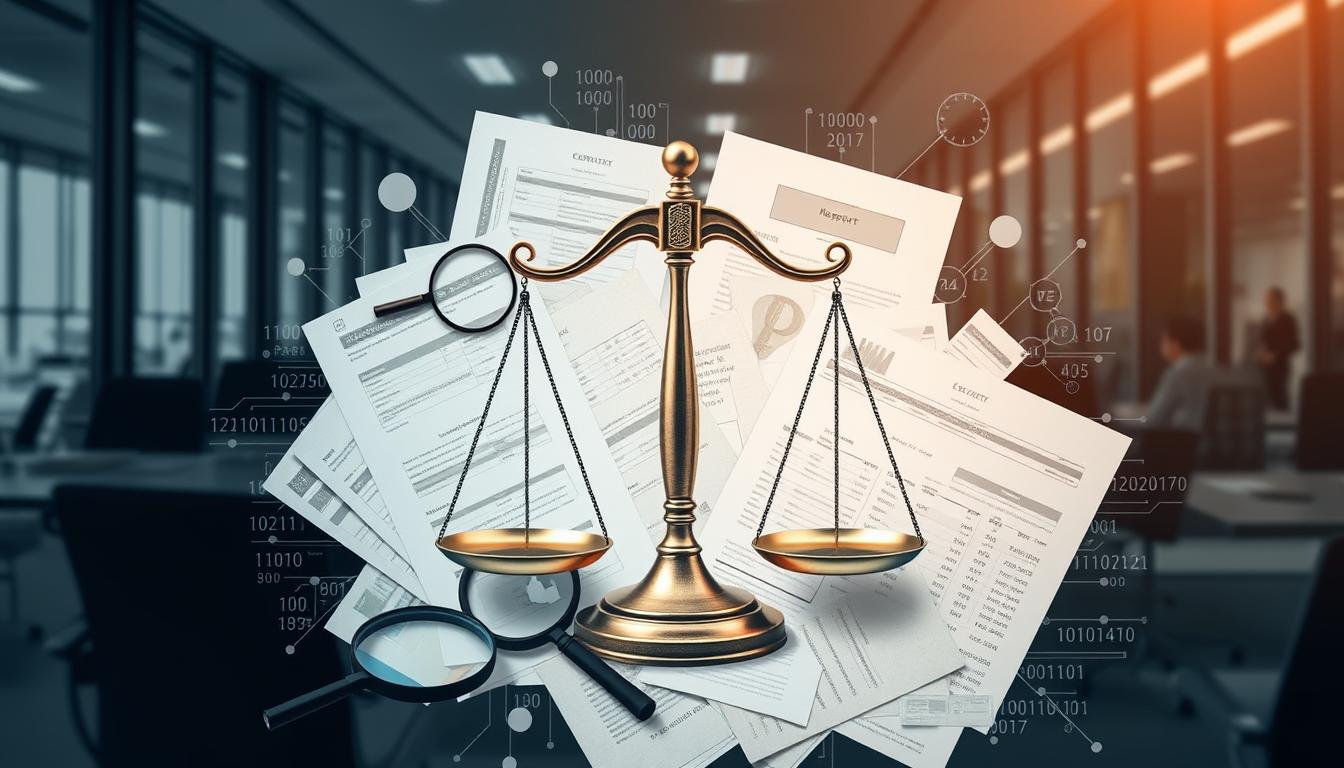Your credit report plays a vital role in your financial life. It affects loans, jobs, and overall financial health. Sadly, errors in credit reports are common and can cause serious problems.
This guide explores the method of verification dispute letter. It’s a powerful tool to fix mistakes on your credit report. You’ll learn how to protect your financial future effectively.
Key Takeaways
- Understand the importance of accurate credit reporting and the common types of errors that can occur.
- Familiarize yourself with the Fair Credit Reporting Act, the legal framework that protects consumer rights in credit reporting.
- Learn the step-by-step process of drafting and submitting an effective method of verification dispute letter.
- Discover the credit bureau investigation process and how to handle creditor responses.
- Explore the potential outcomes of a successful dispute, including credit report corrections and dealing with persistent errors.
Introduction to Credit Reporting Inaccuracies
Credit reports reflect your financial history and creditworthiness. Sadly, these reports aren’t always accurate. Errors can have big consequences for consumers.
Inaccurate information can hurt your credit score. This makes it harder to get loans, credit cards, housing, and jobs.
The Importance of Accurate Credit Reports
Keeping your credit report accurate is vital for financial health. Inaccurate information can lead to higher interest rates, denied credit applications, and even identity theft.
You have the right to dispute errors in your credit reports. It’s crucial to do this to protect your financial well-being.
Common Errors in Credit Reports
Credit reports can contain various errors, including:
- Incorrect personal information, such as a misspelled name or incorrect address
- Accounts that do not belong to the consumer, often due to identity theft or mix-ups with someone with a similar name
- Inaccurate account information, such as incorrect payment history, credit limits, or balances
- Outdated or duplicate information, where the same account is listed multiple times or with incorrect status
- Accounts that should have been removed, such as those related to a bankruptcy or identity theft that have not been properly cleared from the report
These credit report errors can greatly impact your credit score. Address them quickly to protect your identity theft protection.

Understanding the Fair Credit Reporting Act
The Fair Credit Reporting Act (FCRA) protects consumer rights in credit reporting. It sets rules for consumers, credit bureaus, and creditors. The FCRA ensures credit reports are accurate and transparent.
The FCRA allows consumers to dispute wrong information on their credit report. They can contact credit bureaus to investigate and fix any errors. This process helps maintain accurate credit histories.
Consumers can get free credit reports once a year. Credit bureaus must look into disputes quickly. They need to respond to consumers about their findings.
- The FCRA grants consumers the right to access their credit reports for free, typically once per year.
- Credit bureaus must investigate disputes within a reasonable timeframe and provide a response to the consumer.
- Creditors are required to provide accurate and complete information to credit bureaus, and can be held accountable for debt validation if a consumer disputes a debt.
Knowing the Fair Credit Reporting Act helps protect your consumer rights. It ensures your credit report stays accurate. This knowledge helps you make smart choices about your credit.

“The Fair Credit Reporting Act is a critical tool in protecting consumers from inaccurate or incomplete credit reporting, which can have significant financial consequences.”
The Method of Verification Dispute Letter
What is a Method of Verification Dispute Letter?
A method of verification dispute letter helps consumers challenge wrong information on their credit reports. It’s a formal request to credit bureaus to verify disputed items. This ensures your credit file’s accuracy.
When to Use a Method of Verification Dispute Letter
Use this letter when you find errors in your credit report. It’s helpful in specific situations.
- Accounts that do not belong to you or have been incorrectly reported as delinquent or in collections
- Incorrect balances, payment histories, or account statuses
- Accounts that have been reported as open when they should be closed
- Inaccurate personal information, such as your name, address, or social security number
This letter starts a formal investigation by the credit bureau. They must check the disputed information with the creditor. It helps keep your credit report accurate.
An accurate credit report reflects your true financial history. This is key for a good credit score and better credit terms.

| Situation | Appropriate Use of Method of Verification Dispute Letter |
|---|---|
| Accounts not belonging to you | Yes, use the method of verification dispute letter to request the credit bureau investigate and remove the incorrect account. |
| Incorrect account balances or payment histories | Yes, the method of verification dispute letter can be used to correct inaccurate account information. |
| Incorrect personal information | Yes, the method of verification dispute letter can be used to fix errors in your name, address, or Social Security number. |
| Closed accounts reported as open | Yes, the method of verification dispute letter is appropriate to correct the status of closed accounts. |
Knowing how to use this letter helps you keep your credit report accurate. It’s a tool to protect your financial health.
Preparing Your Dispute Letter
An effective method of verification dispute letter is crucial for addressing credit report inaccuracies. Include specific information to support your case. A well-crafted letter increases your chances of success.
Essential Information to Include
When writing your dispute letter, include these key elements:
- Personal Identification Details: Provide your full name, current address, and other relevant personal information. This clearly identifies you as the individual disputing the credit report.
- Specific Credit Report Errors: Clearly identify errors or inaccuracies in your credit report. These may include incorrect account information, fraudulent activity, or mistaken personal details.
- Supporting Documentation: Gather documents, records, or evidence that support your claims. Include bank statements, payment receipts, or correspondence with creditors.
- Requested Action: State the action you want the credit bureau to take. This could be removing disputed items, correcting information, or contacting creditors for verification.
Provide this information clearly and in an organized manner. This creates a compelling case for the credit bureau to investigate the credit report error.
A well-crafted letter is vital for resolving creditor response issues. It also helps validate debt on your credit report. Prepare a thorough letter to achieve accurate credit reporting.
Submitting Your Dispute Letter
After writing your method of verification dispute letter, send it to the right places. This step is key for starting a credit bureau investigation and getting a quick creditor response about debt validation.
Mail your letter by certified post to Experian, Equifax, and TransUnion. This method gives you proof of delivery. It also starts the 30-day window for bureaus to investigate your claim.
- Get a tracking number for your certified mail.
- Keep a copy of the letter and supporting documents.
- Watch your credit report for updates on your dispute.
Send a copy of the letter to any creditors listed in your credit report. This informs them about the investigation. It also prepares them to provide debt validation info if needed.

These steps ensure your method of verification dispute letter is sent correctly. They also set the stage for fixing any errors in your credit report quickly.
Credit Bureau Investigation Process
Credit bureaus must investigate disputed information when you submit a verification letter. This process ensures your credit reports are accurate. It’s crucial for maintaining the integrity of your financial profile.
Creditor Response and Documentation
Credit bureaus contact creditors about disputed items during investigations. Creditors must provide proof to support the reported data. This may include contracts, payment histories, or other evidence.
Creditors have 30 days to respond to the credit bureau’s request. If they can’t validate the information, the bureau must remove it from your report.
- The credit bureaus must investigate the disputed information within a specific timeframe, usually 30-45 days.
- Creditors are required to provide documentation to validate the accuracy of the reported data.
- If the creditor cannot validate the information, the credit bureau must remove the disputed item from your credit report.
The investigation process addresses credit reporting inaccuracies and verifies creditor response. It ensures proper debt validation. Understanding this process helps you protect your credit report’s accuracy.
Handling Creditor Responses
Consumers may receive various responses from creditors after submitting a method of verification dispute letter. Understanding these communications is key to resolving credit reporting inaccuracies. Let’s explore how to interpret and respond to creditor messages.
We’ll guide you through debt validation and obtaining proof of creditor claims. We’ll also discuss how this process can affect your credit score.
Debt Validation and Creditor Proof
Creditors must provide proof of the debt after receiving your dispute letter. This process, called debt validation, ensures your credit report’s accuracy. If creditors fail to provide documentation, they must remove the disputed item.
Carefully review any documentation provided by creditors. Look for clear evidence that the debt is valid and accurately reported. If the proof is insufficient, you may need to escalate the dispute.
| Creditor Response | Appropriate Action |
|---|---|
| Creditor provides valid documentation | Accept the creditor’s response and continue monitoring your credit report |
| Creditor fails to provide adequate proof | Escalate the dispute and request the item be removed from your credit report |
| Creditor’s proof is questionable or incomplete | Challenge the creditor’s response and provide additional evidence to support your dispute |
The creditor response and debt validation process can significantly impact your credit score. Ensure creditors provide necessary proof to protect your financial well-being. This helps maintain an accurate credit history.
Potential Outcomes of a Dispute
Disputing credit report inaccuracies can lead to various results. Credit bureaus investigate issues and contact creditors to verify disputed items. This process can correct errors or leave incorrect information unchanged.
Credit Report Correction
If credit bureaus find inaccuracies, they’ll update your report. This can remove negative items and fix wrong details. Such changes can boost your credit score.
Improved credit reports make it easier to get loans and credit cards. They can also help with housing and job opportunities.
Dealing with Persistent Errors
Sometimes, credit bureaus can’t resolve disputed items. This may happen due to lack of evidence or unresponsive creditors. In such cases, you might need to take extra steps.
You could provide more documents or escalate the dispute. Legal action might be necessary in some situations. Stay vigilant and keep working to fix wrong information.
Protecting your credit and financial health requires ongoing effort. Don’t give up if you face challenges in correcting your credit report.

